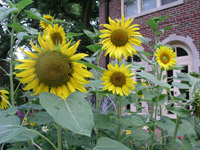
story & photo by Linda Wiggen Kraft
Imagine a house with walls made of sunflowers and a ceiling of morning glories. Each morning the easterly facing sunflowers greet the day and blue trumpets of glory welcome the sun. If we could all be so lucky as to spend some days and nights in such a home.
For some lucky children and adults this experience is reality not fantasy. This heavenly home was made famous in the book Sunflower Houses by Sharon Lovejoy first published in 1991. The author collected gardening stories from elderly women and men. One women described growing up in Kansas where each summer her mother scratched out the rectangular outline of a house in the garden dirt, leaving an opening to enter in. Then sunflower and morning glory seeds were planted along the outline of the house. As the strong stalks of the sunflowers grew, they supported the vines. When the sunflowers were tall enough, strings were placed across the ceiling space and the morning glories grew across.
I love the idea of sunflower houses. Many sunflower houses have been created over the years and images can be found online. A friend created one in her daughter’s elementary school years ago and I spent a day loving the inside and outside. This year I finally got to plant a sunflower house for two young boys as a way to surround their sandbox area with blooming yellow sunflower like plants.
Most sunflower houses are grown with familiar annual sunflower seeds, helianthus annuus, which are native to the Americas. There are other sunflower like plants that can be used. For the sunflower house I planted I used a native perennial, cup plant, with small composite sunflower like flowers and very strong tall stems. These plants will provide shade and attract wildlife. Being perennials they will come back each year. Cup plant, silphium perfoliatum, grows about 8 feet tall. It is called cup plant because the area where the leaves and stem meet holds water like a cup, thereby providing moisture for birds and insects. Cup plant is considered one of the best plants to attract birds and insects by providing food, shelter and water.
In my own gardens, I don’t have a sunflower house, but there are many sunflowers. I throw sunflower birdseed onto the garden beds in the winter. The birds and other animals leave behind some seeds that germinate. The plants that grow have smaller flowers then the big sunflower seed heads, but the goldfinches and other creatures don’t mind the size. They also like the cup plants that grow along the side of my house providing something for them and enjoyment for me as I watch them out my window.
Linda Wiggen Kraft is a landscape designer whose work centers around holistic and sustainable gardens. She is also a mandala artist and workshop leader. Visit Linda Wiggen Kraft’s blog: www.CreativityForTheSoul.com/blog. Her website is: www.CreativityForTheSoul.com. She can be contacted at 314 504-4266.


